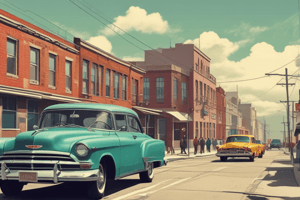Podcast
Questions and Answers
Who was the President of the United States at the beginning of the 1920s?
Who was the President of the United States at the beginning of the 1920s?
Calvin Coolidge
What was President Coolidge's stance on government intervention in business?
What was President Coolidge's stance on government intervention in business?
He was against government intervention
Who benefited the most from the tax cuts proposed by President Coolidge?
Who benefited the most from the tax cuts proposed by President Coolidge?
People who made more than $100,000 a year
What industry did President Coolidge oversee the expansion of?
What industry did President Coolidge oversee the expansion of?
What was President Coolidge's stance on aiding farmers and people living in rural areas?
What was President Coolidge's stance on aiding farmers and people living in rural areas?
How did President Coolidge's tax cuts primarily benefit the American population?
How did President Coolidge's tax cuts primarily benefit the American population?
What were President Coolidge's views and actions regarding the support for farmers and rural areas?
What were President Coolidge's views and actions regarding the support for farmers and rural areas?
How did President Coolidge's policies on taxes reflect the distribution of wealth in the United States?
How did President Coolidge's policies on taxes reflect the distribution of wealth in the United States?
What were President Coolidge's main policy goals and how did they align with his pro-business stance?
What were President Coolidge's main policy goals and how did they align with his pro-business stance?
In what ways did economic troubles threaten the stability of the United States during the 1920s?
In what ways did economic troubles threaten the stability of the United States during the 1920s?
Flashcards are hidden until you start studying
Study Notes
President Coolidge in the 1920s
- Calvin Coolidge was the President of the United States at the beginning of the 1920s.
Economic Policies
- President Coolidge believed in minimal government intervention in business, promoting a laissez-faire approach.
- He proposed significant tax cuts, which primarily benefited the wealthy and large corporations.
Industry and Agriculture
- President Coolidge oversaw the expansion of the radio industry during his presidency.
- He was not in favor of aiding farmers and people living in rural areas, taking a more individualistic approach.
Taxation and Wealth Distribution
- President Coolidge's tax cuts mainly benefited the wealthy, further widening the wealth gap in the United States.
- His policies reflected the distribution of wealth in the United States, with the wealthy holding a significant portion of the nation's wealth.
Policy Goals and Pro-Business Stance
- President Coolidge's main policy goals aligned with his pro-business stance, promoting limited government intervention and reducing taxes for the wealthy.
Economic Troubles of the 1920s
- Economic troubles, including overproduction and underconsumption, threatened the stability of the United States during the 1920s.
Studying That Suits You
Use AI to generate personalized quizzes and flashcards to suit your learning preferences.




